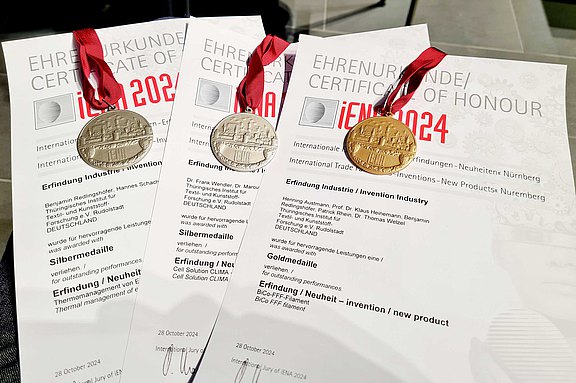Once again this year, TITK returned very successfully from the international trade fair “Ideas - Inventions - Innovations” (iENA) in Nuremberg. This time with one gold and two silver medals. Each of the three innovations presented by TITK was rated as an “outstanding achievement” by the international jury.
Nuremberg – A gold medal goes to the team from the Functional Polymer Systems department, which also includes the Additive Manufacturing research group. It had developed new bicomponent filaments for 3D printing - in this case specifically for the FFF melt layer process. These filaments (continuous filaments) consist of thermoplastic polymers and have a core-shell structure that varies depending on the intended use. Individually adapted formulations can be used to improve important properties such as mechanical strength, thermal stability and warpage behavior of the printed parts. Furthermore, functional polymers that are electrically conductive or antimicrobially effective, for example, can be integrated into the core or cladding.
A silver medal each the iENA jury awarded to the temperature-regulating lyocell fiber Cell Solution® CLIMA and a new innovation for improved thermal management of electric motors.
The CLIMA fiber is a modified cellulose fiber with a special function. The environmentally friendly and sustainable fiber can absorb excess body heat and release it again when temperatures drop. This makes it possible to produce functional textiles that guarantee exceptional comfort and an excellent microclimate. Cell Solution® CLIMA fibers naturally offer excellent moisture management as well as high energy absorption of more than 80 joules per gram of fiber for 6.7 dtex and more than 50 joules per gram for 2.3 dtex fibers. The fibers are particularly suitable for use in textiles for clothing, bed fillings and covers, technical textiles, leisure and medical applications. The temperature regulation is achieved by a firmly incorporated phase change material (PCM).
The same material is used in the third innovation: a plastic compound that can passively cool electric motors. As a practical application example, TITK presented an electrical winding body at the iENA, which is used in transformers, converters, rotors and stators of electrical machines. The plastic compound was incorporated into the cavities between the windings.
Specifically: a composite material with a matrix of a thermoplastic elastomer (TPE) and a phase change material (PCM). This innovative mixture ensures optimized usage properties and integrated overheating protection. As a result, the winding body has improved heat dissipation, vibration damping and at the same time fixation of the windings.

